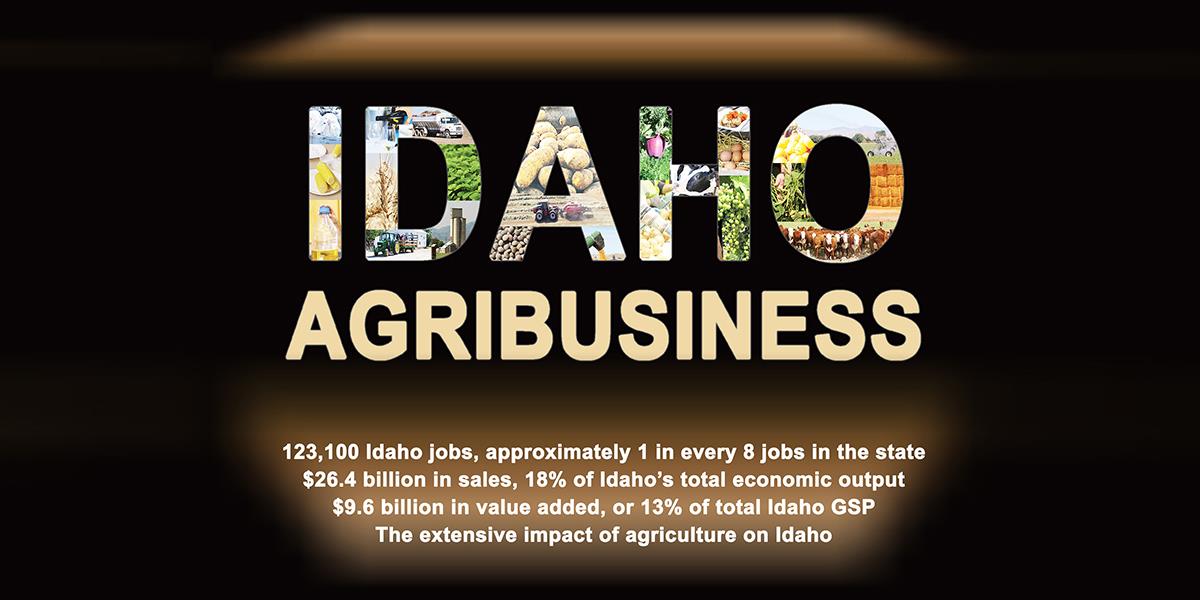How vital is agriculture to Idaho?

By Sean Ellis
Idaho Farm Bureau Federation
POCATELLO – Agriculture is critically important to Idaho’s economy, according to a recent University of Idaho Extension report.
It is based on 2017 data and updates a previous report based on 2014 data.
According to the report, “Economic Contribution of Idaho Agribusiness,” agriculture was directly and indirectly responsible for 123,100 jobs in 2017, or one in every eight jobs in the state.
Agribusiness, which includes crop and livestock production and the processing of agricultural products, also generated 13 percent of Idaho’s total gross state product in 2017.
“We’re talking 13 percent of the state’s economy. That’s a significant sector of Idaho’s economy,” said the report’s author, Philip Watson, an associate professor in U of I’s College of Agricultural and Life Sciences.
The report, which was published in January and is based on several sources, including data from USDA and the U.S. Bureau of Economic Analysis, found agriculture was also responsible for $26.4 billion in sales or 18 percent of Idaho’s total economic output.
“By that measure, it makes agriculture the largest sector in the state of Idaho,” said U of I Agricultural Economist Garth Taylor. “That is an astounding number.”
One in every $9 in wages paid in the state of Idaho can be attributed to agriculture, according to the report.
Agriculture’s impact on Idaho’s economy in 2017 actually decreased slightly from the previous report that was based on 2014 numbers. But Watson pointed out that 2014 was a record year for Idaho agriculture in terms of total farm cash receipts and it was anticipated that agriculture’s impact, on a percentage basis, would be down a little.
Idaho farmers and ranchers brought in a record $8.8 billion in farm cash receipts in 2014 but that number dropped to $7.2 billion in 2017. Total net farm income in Idaho was $2 billion in 2014 but $1.23 billion in 2014.
“The impact is down slightly from that high in 2014 but agriculture is still a very big player in Idaho’s economy, that’s for sure,” Watson said.
In calculating how important different sectors are to the state’s economy, Watson attributed every dollar generated in state GSP to a specific sector, so there was no double counting.
For comparison’s sake, technology manufacturing, which includes computers, electronic equipment and other electronics, accounted for 7 percent of Idaho’s total GSP.
Agriculture’s total impact on the state’s economy includes its indirect impacts on other sectors. For example, it would include the sale of a tire tractor to a wheat producer.
“There are lots of segments of Idaho’s economy that we wouldn’t have if we didn’t have agriculture,” Watson said.
Taylor said that every industry sector has indirect “multiplier” effects on the economy but the indirect impacts from agriculture are bigger because almost all the food produced in Idaho is exported to other states or nations.
 According to the Idaho State Department of Agriculture, if Idahoans had to consume all the farm products produced within the state, they would have to eat, every day, 43 potatoes, 2 pounds of cheese, 180 slices of bread, two onions, 2 pounds of beef and three cups of beans.
According to the Idaho State Department of Agriculture, if Idahoans had to consume all the farm products produced within the state, they would have to eat, every day, 43 potatoes, 2 pounds of cheese, 180 slices of bread, two onions, 2 pounds of beef and three cups of beans.
“It is the exports that create new wealth in an economy,” Taylor said. “Agribusiness is creating a lot more exports and has a bigger multiplier than other industries. Obviously, we cannot consume the milk, potatoes and other products we produce. It’s almost all exported out of the state.”
Watson said one thing that jumps out of the data that was used to create the report is that the percent of Idaho’s GSP that comes from farm production is higher than the percent of state GSP that comes from food processing.
That, he said, is not the case for most big farming states.
“That’s a very unusual phenomenon,” he said. “It is ma and pa farmer doing the lion’s share of the work.”
A separate report by Taylor found that total Idaho GSP from production agriculture grew twice as fast as the state’s overall GSP from 1997-2017, while the food processing sector’s percentage of total state GSP increased slightly during that time.
As he told lawmakers in January, Idaho agriculture’s GSP growth is being driven largely “by grandma and grandpa on a tractor.”
Watson’s report shows that agriculture’s importance to Idaho’s economy is much greater than it is in surrounding states and the U.S. as a whole.
It found that agriculture’s importance to Idaho’s economy is 12.4 times greater than it is in Nevada, 4 times greater than in Utah, 3.9 times greater than in Montana, 3.4 times greater than in Washington, 2.7 times greater than in Oregon and 3.3 times greater than in the U.S. overall.
A report prepared last year by U of I Agricultural Economist Ben Eborn showed that when it comes to farm cash receipts on a per capita basis, Idaho is an unchallenged No. 1 among the 11 Western states.
That report, which was based on USDA Economic Research Service data, found that in 2017, Idaho agriculture generated $4,287 in farm cash receipts per person in the state, far more than California ($1,266), which leads the nation in total farm receipts. No other state was even close to Idaho in that category.
According to Watson’s report, Idaho ranked in the top five among the states in the production of 16 farm commodities, based on National Agricultural Statistics Data from 2017.
That included No. 1 in four commodities, (potatoes, barley, trout and Austrian winter peas), No. 2 in five commodities (sugar beets, hops, alfalfa, peppermint oil and wrinkled seed peas), No. 3 in cheese, No. 4 in five categories (milk, onions, lentils, spearmint oil and number of milk cows) and No. 5 in dry beans.
Still can't find what you are looking for? Find by topic:
- Achievement Award (YF&R)
- Actions Alerts
- Advocacy
- Ag Ambassadors
- American Farm Bureau
- American Farm Bureau Policy Book
- Archive Photos
- Articles
- Board of Directors
- Calendar - State/District
- Calendar - County
- Capitol Reflections
- Collegiate Chapters
- Committee Application Form
- Commodities
- Convention Annual
- County Presidents & Board Information
- County Resource Page
- Delegate Form
- Discount Programs
- Discussion Meet
- Discussion Meet - High School
- Education Programs
- Events
- Excellence Award (YF&R)
- Expense Voucher
- Flickr
- Gem State Producer
- High School Discussion Meet
- High School Speech Contest
- Hope in Idaho Ag
- House of Delegates Credentials Form
- IFBF Board of Directors
- IFBF Policy Book
- IFBF Staff
- Insurance
- Legislative Action Program
- Legislative Issues
- Library
- MAC Trailer
- Magazines
- Map My Benefits
- Member Benefits
- Member Discount
- Membership Application
- Mission Statement
- Moving Agriculture to the Classroom
- Newsletter Sign up
- News Releases
- News Room
- Open Range Law
